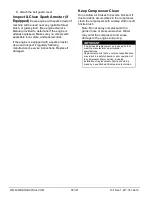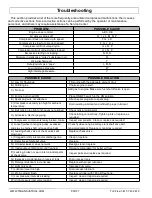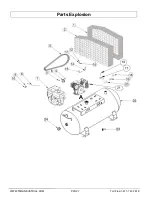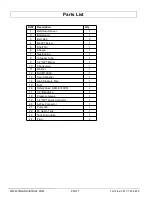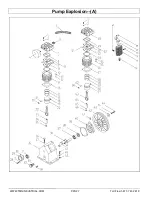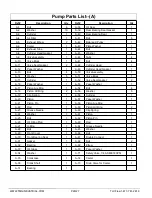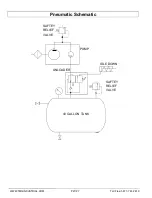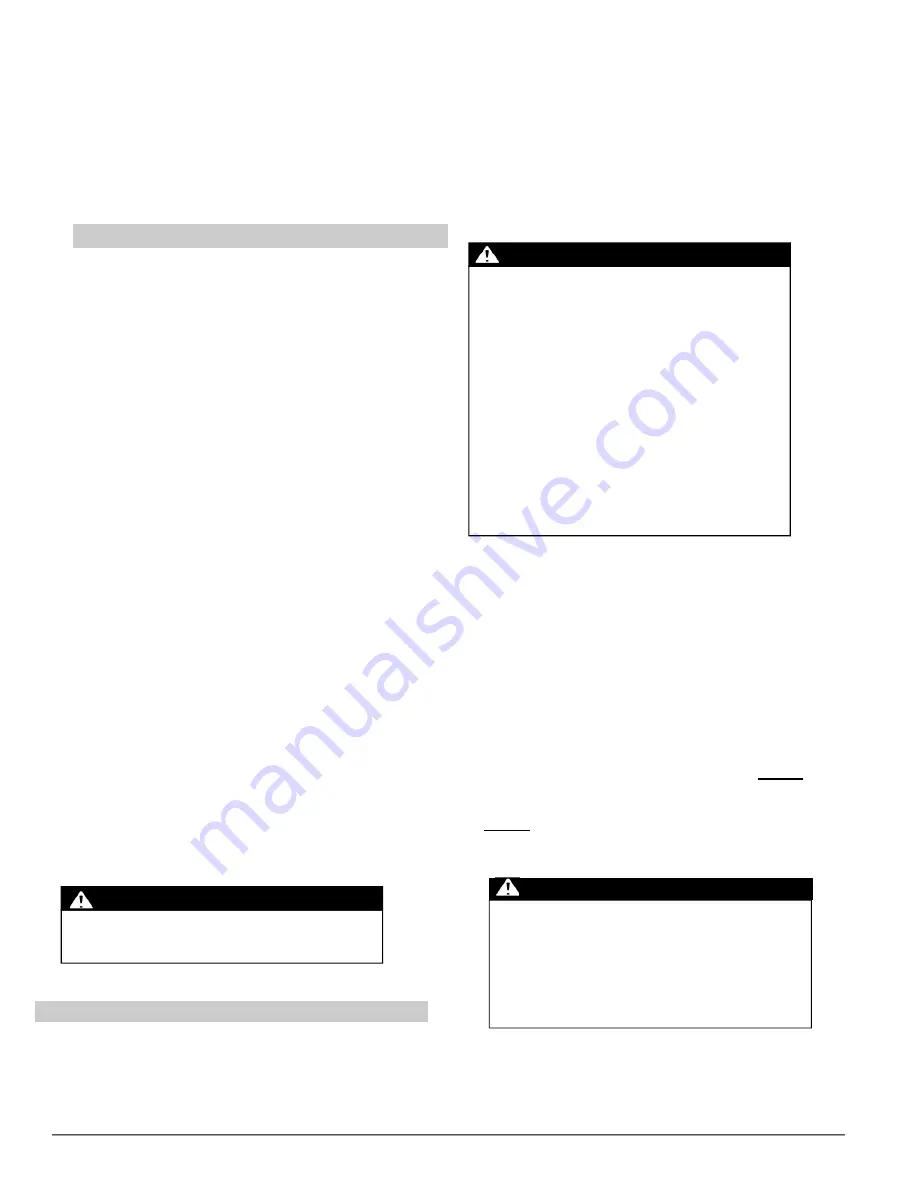
WWW.TMGINDUSTRIAL.COM
P12/27
Toll Free:1-877-761-2819
Note: In frequently humid areas, moisture may
form in the pump and produce sludge in the oil,
causing parts to wear out prematurely.
Excessive moisture is likely to occur if unit is
stored in an unheated area subject to large
temperature changes.
Two signs of excessive humidity are external
condensation on the pump when it cools down and
a “milky” appearance in pump oil.
Step 3. Mounting
1.
Lift and remove the compressor from the
pallet using a hoist and lifting eyes provided.
2.
Situate unit in chosen location and bolt in place.
Bolt it in place to prevent unit from vibrating
excessively. Use metal shims under the “short”
feet if necessary.
3.
A rubber isolation mat or pads may be used
under each mounting foot to reduce vibration.
Mounting on Service Vehicle
If installing unit on a service vehicle you must:
• Locate unit in an open-air environment, away from
driver and passengers.
• Fasten unit securely without applying excessive
stress on the receiver/storage tank. Truck beds
have a tendency to flex and could cause damage to
the receiver tank if fastened directly to the truck bed.
It is the user’s responsibility to provide an adequate
means of fastening the unit in these applications.
• Direct exhaust and other hot parts of compressor
away from the cab or flammable equipment. Make
sure the exhaust clears the side of the bed.
• Securely close (and preferably drain) gas tank to
prevent fuel leakage during transportation.
Installing Discharge Piping
If installing discharge piping you must:
• Adhere to all local building codes.
• Use discharge piping of the same diameter as the
compressor discharge connection.
• Use pipe, tube, hose, or distribution components rated
for use with compressed air and maximum pressure
of this compressor.
• Use a properly rated flexible connection between the
tank and discharge piping.
Do not use plastic (PVC) pipe, rubber hose,
copper, or lead-tin soldered joints anywhere in the
compressed air system.
WARNING: Burst hazard
Step 4. Electrical Starting: Battery Procedure
In addition to the recoil starter, the engine is capable of
electric starting which, if used, will require the purchaser
to provide a hook-up to an external 12-volt size battery .
Battery should have a minimum rating of 18 amp-hour.
You may also choose to use a “jump” from a service
vehicle’s battery or an external battery set on the
ground.
See engine Owner’s Manual for more information
regarding battery cable size and length
recommendations.
Follow instructions below for connecting and
disconnecting the battery. After starting engine,
a battery is not required, but can remain
connected without damaging the compressor.
Battery Connection
Always connect the cables in the following sequence to
avoid possible shock.
1.Connect one end of the
red
(+) cable to
compressor engine’s starter solenoid terminal.
Note: Access to the solenoid terminal is from the top
may require reaching between the gasoline tank and
shroud covering the compressor’s cooling fan.
2.
Connect one end of the
black
(-) cable to
compressor engine’s mounting bolt, frame bolt, or
other good engine ground connection.
3.Connect other end of the
red
(+) cable to battery
positive (+) terminal.
4.Connect other end of the
black
(-) cable to
battery negative (-) terminal as shown.
5.Coat terminals and cable ends with grease if they are
to remain permanently connected .
CAUTION: Battery connection
hazard
Be careful not to connect the battery in reverse
polarity, as this will short circuit the battery
charging system.
Since the engine has not yet been grounded to
the battery ground, your uninsulated tool handles
can cause a short circuit if they also touch a
grounded part while tightening the positive
battery cable end.
Batteries contain caustic acid, can emit explosive
gases, and can cause electric shock. Caution
must be exercised when making connections to
a battery to avoid shock, contact with acid, and
prevent any sparking that could lead to an
explosion.
Eye/skin protection.
Always wear eye
protection and protective clothing when
connecting or disconnecting battery.
Electric shock Prevention.
Never touch both
battery terminals at the same time with your
hand or any non- insulated tools.
Acid/skin contact.
If battery acid contacts skin
or clothing, flush immediately with water and
neutralize with baking soda.
WARNING: Battery hazards





















